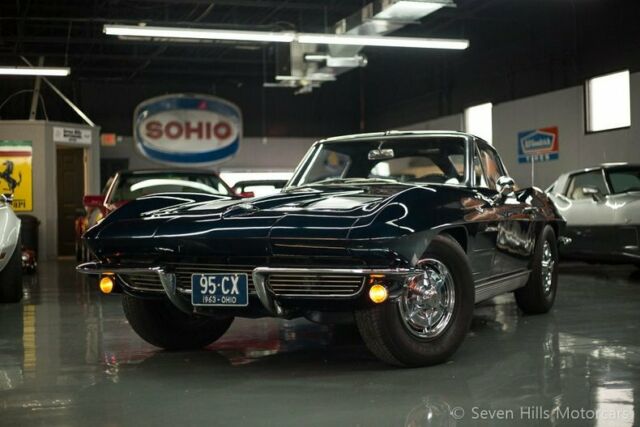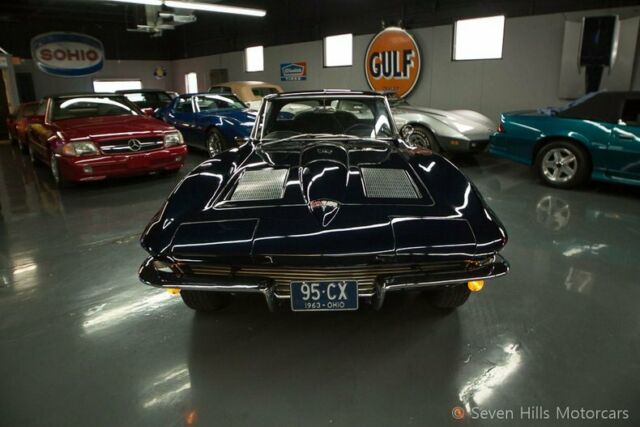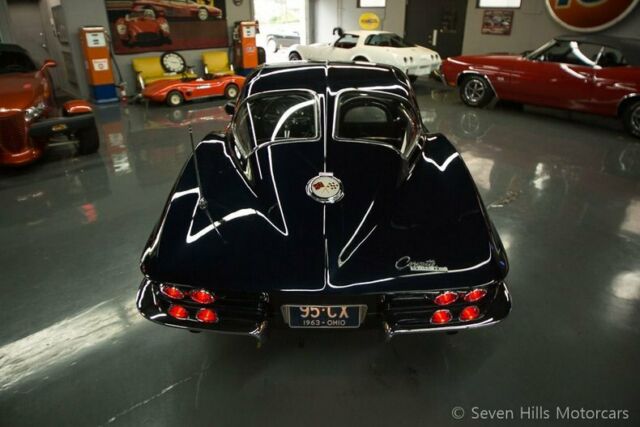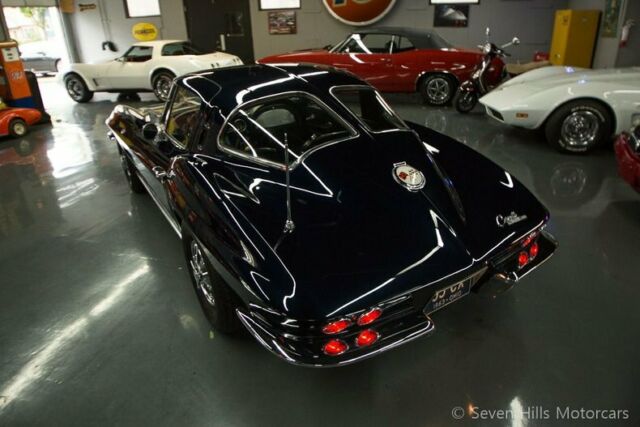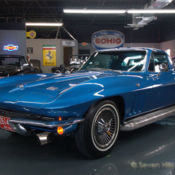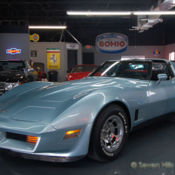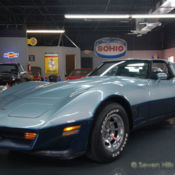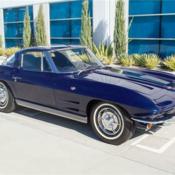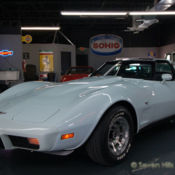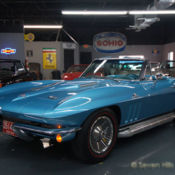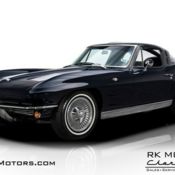Split Window Coupe, EXCELLENT CONDITION, Daytona Blue/Blue PRICED TO SELL!!
1963 Chevrolet Corvette ONLY 25,685 ORIGINAL MILES
Seven Hills Motorcars | eBay Motors 513-708-1468 9213 Blue Ash Rd Cincinnati, OH 45242 sevenhillsmotorcars.com 1963 Chevrolet Corvette
.... Seven Hills Motorcars is proud to offer this absolutely stunning 1963 Corvette Sting Ray Split Window Coupe in wonderful driver condition and showing only 25,685 miles!! The clear Ohio title shows the mileage as actual and the previous owner also stated the mileage as correct and original. This Corvette looks fantastic, runs great, and is an excellent driver. The Split Window Coupes are some of the most beautiful, sought-after, and popular Corvettes ever made. We are offering a great opportunity to own a very desirable Corvette model at an unbeatable value. The market on C2 Corvettes is hot right now and on the rise, especially for the '63 Split Windows; one could easily buy this car now and sell it for more than the purchase price in years to come. This Split Window looks absolutely amazing in Blue/Blue. We have found recently that Blue Corvettes sell better for us than any other color, even Red. The Daytona Blue (916A) over Dark Blue Vinyl (490A) color combination is highly desirable, truly striking, and looks great on this Corvette Sting Ray body style. It is also the correct and original color scheme as verified by the codes on the trim tag, which is pictured below. Please peruse all of the photos, video, list of numbers, and other information to get a true sense of how nice and clean this Corvette Sting Ray really is. As a side note, this Corvette is not a dealer auction vehicle. Our Corvettes come from owners who expect their car to go to someone that will give the vehicle the same care and attention as they did. We invite and encourage you to examine the car in person or have the car inspected. Please take the time to scrutinize each picture. We photograph each vehicle to the greatest extent so you can feel confident about your purchase. If you have a question about the Corvette, just give us a call. Model Description 1963 marked the most significant new model introduction ever for Corvette. The 1963 Corvette was completely fresh throughout with a stunning new "String Ray" body and all new independent rear suspension. Under the direction of Bill Mitchell the new Corvette was penned by Larry Shinoda. It was based on Bill Mitchell's 1959 Stingray racer and the 1961 Mako Shark. The new Corvette was a radical departure from anything sold to the public at the time. They were lower (almost three inches) narrower (3 inches) and shorter by two inches than the previous generation. Their sleekness was indisputable. If you compare it to the other domestic offerings, it is easy to understand the impact it had. Wherever their owners took them, racetrack, boulevard or rally, the new Corvette looked like it belonged The independent rear suspension Duntov created for Sting Ray was simple yet effective. It was essentially a frame-mounted differential with U-jointed half-shafts tied together by a transverse leaf spring. Rubber-cushioned struts carried the differential, which reduced ride harshness while improving tire adhesion, especially on rougher roads. The transverse spring was bolted to the rear of the differential case. A control arm extended laterally and slightly forward from each side of the case to a hub carrier, with a trailing radius rod mounted behind it. The half-shafts functioned like upper control arms. The lower arms controlled vertical wheel motion, while the trailing rods took care of fore/aft wheel motion and transferred braking torque to the frame. Shock absorbers were conventional twin-tube units. Considerably lighter than the old solid axle, the new rear suspension array delivered a significant reduction in unsprung weight, which was important since the 1963 model would retain the previous generation's outboard rear brakes.. ExteriorThe Daytona Blue exterior is in excellent driver condition. As one can see in the photos the finish has a terrific gloss, deep shine, and smooth finish. The chrome and other bright work look fantastic with a brilliant finish. The hubcaps have a great finish and no curb rash. The black wall tires have about 95% tread left. There are no major blemishes that have been excluded from the photos. There is a small imperfection on the left rear decklid visible in the photos and as one would expect from a paintjob with this many years on it there are some others that were too faint to show up in the photos, but nothing else really noticeable from about five or ten feet away. As one can see in the many photos of the underside of the car, it is very clean and this Corvette has absolutely NO RUST ISSUES. The frame is totally solid with no rust around the end plate in front of the rear tire. We have included specific photos of the areas most prone to rust to show how nice this car looks. Please note that ALL of the glass on this Corvette, the windshield, both pieces of door glass, both rear windows, and even the vent windows, are all date coded and original as each piece predates the car's body build date of the fifth week of October of 1962 (B5). Original glass is a good indication that this car has had no accident history. InteriorThe Dark Blue interior in this Sting Ray is in outstanding condition. The seats are in excellent shape with no split seams, rips, or excessive wear. The seats are not worn in the typical area where the driver gets in and out. The carpet is also in good condition with no holes or rips. This includes the rear carpet, which is often neglected. The gauge faces are crisp and clean and the lenses are clear. The door panels are in terrific shape; there are no cracks in the typical spot where the driver's elbow sits. The door pulls are solid and intact. The dash and console look great with no cracks or sun fading. The original radio does not work, but most importantly the dash has never been cut or modified for an aftermarket installation. This Corvette has never been smoked in; there are no burns marks and no aroma of cigarettes. This Corvette seems to be in good mechanical condition. It starts right away every time, runs well, and idles smooth. It drives great and feels nice on the road and at highway speeds. In the video below one can observe the car accelerating on the highway up to about 70mph, shifting through all the gears, braking to stoplight, and going through some curves. Please note that there are no strange noises or vibrations and the car performs quite well overall. The brakes are responsive and do not pull to one side or the other, which is a very common issue on the early C2 Corvettes. The Hurst shifter is tight, the transmission does not pop out of gear, and the clutch feels good. Also, the engine compartment is beautifully clean and detailed as one can see in the photos. The wipers work as do all the exterior lights, indicators, dash lights, interior lights, and blower for the heater on all speeds. All of the gauges work and even the clock runs. The headlights work very well and go up and down properly, which is another very common problem on Mid Year Corvettes. The entire operation of the headlights can be viewed in the video. The horn does not work. Not enough can be said as to how much of a pleasure it is to drive this car. Overall ConditionOverall, this 1963 Corvette Sting Ray Split Window Coupe is in great driver condition. This car gets a ton of attention and compliments wherever it goes. The low mileage showing on the odometer and title as well as the fantastic color combination and the originality make this Corvette particularly admired and almost impossible to duplicate. The coupe examples in this year draw a huge premium over a Corvette Coupe from another year or a convertible. This Sting Ray is a great value and we have it priced to sell. Mid-year (C2) Corvettes are, and will continue to be, the most collectable and desirable Corvette generation and the Split Window Coupe is one of the best to own. The value of these cars has gone up exponentially in recent years. They are all solid investments for a collector. One could easily enjoy this vehicle for several years and sell it for more than the purchase price with minimal effort. Thank you for looking and please do not hesitate to email or call with any questions.
|
- Condition: Used
- Make: Chevrolet
- Model: Corvette
- SubModel: ONLY 25,685 ORIGINAL MILES
- Type: Coupe
- Trim: ONLY 25,685 ORIGINAL MILES
- Doors: 2
- Year: 1963
- Mileage: 25685
- VIN: 30837S102762
- Color: Blue
- Engine size: 327ci
- Transmission: Manual
- Interior color: Blue
- Vehicle Title: Clear Want to buy? Contact seller!
